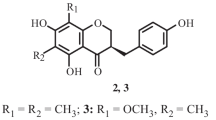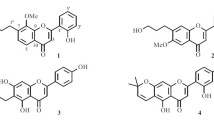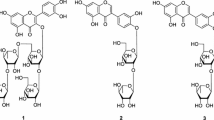One new flavonol glycoside (1), together with one known flavonol glycoside (2) and 16 known megastigmanes (3–18) were isolated from the whole plant of Sedum sarmentosum Bunge. Their structures were established by spectroscopic data (1D, 2D NMR, and HR-ESI-MS) and comparison with the literature. Among them, compounds 8 and 10–12 were reported from the Crassulaceae family for the first time. Anti-inflammatory effects of the isolated compounds were evaluated in terms of inhibition of NO, TNF-α, and IL-6 production in lipopolysaccharide-stimulated RAW 264.7 cells. Compounds 8 and 16 could inhibit NO production with IC50 values of 47.93 ± 3.43 μM and 47.11 ± 3.63 μM. Compounds 4 and 6 showed an inhibitory effect on IL-6 production with IC50 values of 34.37 ± 4.84 μM and 38.26 ± 3.32 μM.
Similar content being viewed by others
Avoid common mistakes on your manuscript.
Sedum sarmentosum Bunge is a perennial herbaceous plant belonging to the Sedum genus (Crassulaceae). It is mainly distributed on mountain slopes in China, Korea, and Japan [1]. As a traditional medicinal plant, the whole S. sarmentosum plant has been used to treat dysentery, pimples, and sore throat [2]. Previous phytochemical studies on S. sarmentosum have revealed that the plant contains a variety of chemical constituents, including megastigmanes, flavonoids, alkaloids, and terpenoids [3,4,5]. Recent pharmacological studies have indicated that S. sarmentosum possesses multiple biological activities such as liver protection [6], antioxidant [6], antitumor [7], and anti-inflammatory [8]. To discover potential novel bioactive constituents from S. sarmentosum, the EtOAc-soluble extract was subjected to column chromatography and preparative middle-pressure liquid chromatography to yield a new flavonoid glycoside 1 and 17 known compounds (2–18). All isolated compounds were evaluated for NO, TNF-α, and IL-6 inhibitory activities in LPS-induced RAW 264.7 cells.
Compound 1 was isolated as a yellow powder. In the HR-ESI-MS spectrum, it gave an intense [M + H]+ peak at m/z 479.1176 (calcd for C22H23O12, 479.1184), corresponding to the molecular formula C22H22O12. The 1H NMR spectrum (Table 1) of 1 indicated the presence of an ABX-spin coupling system at δ 8.06 (1H, d, J = 1.9 Hz, H-2′), 7.72 (1H, dd, J = 8.5, 1.9 Hz, H-6′), and 6.95 (1H, d, J = 8.5 Hz, H-5′) in the B-ring, one aromatic proton at δ 6.29 (1H, s, H-6) in the A-ring, an anomeric proton signal at δ 5.21 (1H, d, J = 6.8 Hz, H-1′′) and other proton signals of sugar at δ 3.90 (1H, m, H-2′′), 3.86 (1H, m, H-4′′), 3.83 (1H, m, H-5′′a), 3.66 (1H, dd, J = 8.7, 3.1 Hz, H-3′′), and 3.49 (1H, m, H-5′′b), together with two methoxy groups at δ 3.98 (3H, s, 3′-OCH3) and 3.92 (3H, s, 8-OCH3). The 13C NMR spectrum exhibited 22 carbon signals, comprising a carbonyl carbon at δ 179.6 (C-4), two olefinic carbons at 158.4 (C-2) and 135.5 (C-3) in the C-ring, an 1,3,4-trisubstituted benzyl unit at δ 151.1 (C-4′), 148.6 (C-3′), 123.8 (C-1′), 122.9 (C-6′), 116.2 (C-5′), and 114.2 (C-2′) in the B-ring, a pentasubstituted aromatic system at δ 158.8 (C-7), 158.0 (C-5), 150.3 (C-9), 129.1 (C-8), 105.6 (C-10), and 100.2 (C-6) in the A-ring, a sugar moiety at δ 104.5 (C-1′′), 74.1 (C-4′′), 72.9 (C-3′′), 69.2 (C-2′′), and 67.3 (C-5′′), along with two methoxy carbons at δ 62.0 (8-OCH3) and 56.8 (3′-OCH3) (Table 1). The NMR spectra indicated that the skeleton of 1 was a flavonoid with a sugar moiety. Acidic hydrolysis followed by GC analysis confirmed the presence of L-arabinose [9]. Both the 1H and 13C NMR chemical shifts and the coupling constant of the anomeric proton doublet (J = 6.8 Hz) were consistent with the published spectra of α-L-arabinopyranoside recorded in methanol-d4 [10, 11]. According to the overall analyses, compound 1 was similar to limocitrin-3-O-β-D-glucopyranoside [12], except that the β-D-glucopyranoside at the C-3 position was replaced by α-L-arabinopyranoside in 1. The sugar linkages were established based on the key HMBC correlations between H-1′′ (δ 5.21) and C-3 (δ 135.5), which indicated that the α-L-arabinopyranosyl group was located at the C-3 position. The HMBC correlations between 3′-OCH3 (δ 3.98) and C-3′ (δ 148.6), 8-OCH3 (δ 3.92) and C-8 (δ 129.1) indicated that two methoxy groups were located at the C-3′ and C-8 positions, respectively (Fig. 1). On the basis of the aforementioned evidence, the structure of 1 was elucidated as limocitrin-3-O-α-L-arabinopyranoside.
The known compounds (2–18) were identified as limocitrin-3-O-β-D-glucopyranoside (2) [12], myrsinionoside A (3) [13], sarmentol C (4) [14], vomifoliol (5) [15], (+)-dehydrovomifoliol (6) [16], sedumoside I (7) [17], neosarmentol III (8) [3], sarmentol A (9) [14], sedumoside A2 (10) [14], sedumoside A3 (11) [14], myrsinionoside D (12) [13], sedumoside E2 (13) [18], sedumoside E1 (14) [18], (3S,5R,6S,9R)-megastigmane-3,9-diol (15) [13], sarmentol D (16) [14], actinidioionoside (17) [19] and (3S,5R,6R,7E,9S)-3,5,6,9-tetrahydroxymegastigman-7-megastigmene (18) [20].
Compounds 1–18 were assayed for their inhibitory effects on the secretion of NO, TNF-α, and IL-6 in LPS-stimulated RAW 264.7 cells using the Griess and ELISA methods. First, all the isolated compounds were tested for their cytotoxic activities using the modified MTT method [21] and no compounds showed significant cytotoxic activity against the RAW 264.7 cells at 100 μM. The bioactivity results showed that compounds 8 and 16 inhibited NO production with IC50 values of 47.93 ± 3.43 μM and 47.11 ± 3.63 μM, respectively. Compounds 4 and 6 showed an inhibitory effect on IL-6 production with IC50 values of 34.37 ± 4.84 μM and 38.26 ± 3.32 μM, respectively (Table 2). In summary, compounds 8 and 16 preferably inhibited NO production, and compounds 4 and 6 showed a better inhibition effect in IL-6 production. Unfortunately, compounds 4, 6, 8, and 16 all exhibited less potent activities than the dexamethasone-positive control group.
EXPERIMENTAL
General. High-resolution electrospray ionisation mass spectra (HR-ESI-MS) were obtained using a Bruker microTOF QII mass spectrometer (Bruker Daltonics, Fremont, CA, USA). The NMR spectra were recorded using Bruker AV 300 MHz spectrometer (Bruker, Fallanden, Switzerland). Optical rotation was measured using a Rudolph Autopol I automatic polarimeter (Rudolph Research Analytical, Hackettstown, NJ, USA). Column chromatography was performed using silica gel (200–300 mesh, Branch of Qingdao Haiyang Chemical Co., Ltd., Qingdao, P. R. China). Middle Pressure Liquid Chromatography (MPLC) was performed on an automatic flash chromatography device (CHEETAH MP-200, Bonna-Agela Technologies Co., Ltd.). Lichroprep RP-18 gel (40–63 μm) was purchased from Merck KGaA (Darmstadt, Germany). TLC was performed with precoated silica gel GF254 glass plates (200 × 200 mm, Branch of Qingdao Haiyang Chemical Co., Ltd.). All other chemicals and solvents were analytical grade and used without further purification.
Plant Material. The dried whole plant of S. sarmentosum was collected from the surrounding region of Yanji City, Jilin Province, in August, 2007. A voucher specimen (voucher No. YB-SYC-0702) was deposited in the Pharmacognosy Laboratory of the College of Pharmacy, Yanbian University, which was identified by Prof. Huizi Lv (College of Pharmacy, Yanbian University).
Extraction and Isolation. The dried whole plant of S. sarmentosum (5 kg) was extracted with 95% EtOH (30 L, thrice, each for 1 week) at room temperature. The crude extract (700 g) was partitioned with CH2Cl2 (3 L, thrice), EtOAc (3 L, thrice), and n-BuOH (3 L, thrice), respectively. The EtOAc extract (30 g) was divided into six fractions (Frs. E1–E6) by a silica gel column (PE–EtOAc, 30:1–3:1). Fraction E5 (17 g) was fractionated into three subfractions (Subfrs. E51–E53) using a reverse-phase column (RP-C18) and eluted with a gradient of MeOH–H2O (1:9–1:0). Subfraction E52 (1.8 g) was re-chromatographed on a silica gel column with a gradient of CH2Cl2–MeOH (30:1–15:1) to yield compounds 3 (32.1 mg) and 9 (15 mg). The n-BuOH extract (420 g) was chromatographed on a silica gel column using CH2Cl2–MeOH (20:1–0:1) to yield nine fractions (Frs. B1–B9). Fraction B1 (12.7 g) was applied to MPLC (Bonna-Agela Flash column, 40–60 μm, ODS, 120 g) with a MeOH–H2O gradient (3:17–1:0) to yield seven subfractions (Subfrs. B11–B17). Subfraction B12 (1.8 g) was purified using a silica gel column with a gradient of PE–EtOAc (5:1–1:1) and an RP-C18 column with a gradient of MeOH–H2O (1:19–3:17) to yield compound 6 (10 mg). Fraction B13 (2.12 g) was purified using RP-C18 column and a gradient of MeOH–H2O (1:4) to yield compounds 4 (166 mg), 5 (15 mg), and 16 (53 mg). Fraction B15 (2.98 g) was chromatographed on an open column using normal-phase silica-gel column and eluted with a gradient of PE–EtOAc (10:1–1:1). The eluates were then purified using an RP-C18 column with MeOH–H2O as mobile phase to yield compounds 15 (144 mg) and 8 (20 mg). Fraction B3 (8.4 g) was separated by MPLC (Bonna-Agela Flash column, 40–60 μm, ODS, 40 g) with a gradient of MeOH–H2O (5:95–60:40) to afford five subfractions (Subfrs. B31–B35). Subfraction B32 (664 mg) was further purified by an open silica gel column using CH2Cl2–MeOH (15:1) and a RP-C18 column using a gradient of MeOH–H2O as a solvent system (1:9–1:4) successively to yield compound 18 (23 mg). Compounds 7 (11 mg) and 12 (17 mg) were acquired from Subfr. B33 (710 mg) over silica gel column with a gradient of PE–EtOAc–MeOH (4:1:0.5). Subfraction B34 was chromatographed on an open silica gel column using CH2Cl2–MeOH (25:1) to yield compounds 1 (10 mg) and 2 (10 mg) successively. Fraction B5 (5.4 g) was loaded onto MPLC (Bonna-Agela Flash column, 40–60 μm, ODS, 40 g) with a gradient of MeOH–H2O (10:90–40:60) to yield eight subfractions (Subfrs. B51–B58). Subfraction B55 (200 mg) was chromatographed on a silica-gel column using mixtures of PE–EtOAc–MeOH (2:1:0.5) to obtain compound 17 (18 mg). Subfraction B56 (450 mg) was fractionated on MPLC (Bonna-Agela Flash column, 40–60 μm, ODS, 12 g) with a gradient of MeOH–H2O (5:95–30:70) to produce a mixture of compounds 10 and 11 (7.5 mg). Subfraction B57 (290 mg) was purified by a silica gel column with CH2Cl2–MeOH (12:1–10:1) to give compounds 13 (25.7 mg) and 14 (11.6 mg).
Limocitrin-3-O-α-L-arabinopyranoside (1), C22H22O12, yellow powder; \({[\mathrm{\alpha }]}_{\mathrm{D}}^{20}\) –11.55° (c 0.29, MeOH). HR-ESI-MS m/z 479.1176 [M + H]+ (calcd 479.1184). 1H and 13C NMR spectral data, see Table 1.
Acid Hydrolysis and Sugar Determination of 1. The specific determination method was performed as previously reported [22]. Compound 1 was hydrolyzed with 1.0 M HCl at 85°C for 2 h and the reaction mixture was partitioned with EtOAc. The aqueous layer was evaporated to yield a residue, and the residue was dissolved in anhydrous pyridine followed by the addition of 0.1 M L-cysteine methyl ester hydrochloride. After heating at 60°C for 2 h, the residue was dried and trimethylsilylated with the addition of a 1-trimethylsilylimidazole solution, and heated at 60°C for 5 min. The dried product was partitioned with n-hexane and H2O, and the nonpolar layer was analyzed using the GC technique. The monosaccharide moiety was confirmed as L-arabinose based on the comparison of the retention time with that of L-arabinose standard (tR 13.65 min).
Inhibitory Activities against Production of NO, TNF-α, and IL-6. Mouse macrophage cell line RAW 264.7 cells were cultured in Dulbecco minimum essential medium (DMEM) supplemented with 100 U/mL of penicillin, 100 U/mL of streptomycin, and 10% heat-inactivated fetal bovine serum (FBS). The cells were incubated in a humidified incubator with an atmosphere of 5% CO2 at 37°C and were subcultured upon reaching 70–80% confluent level. Cell viability was measured by the MTT assay. RAW264.7 cells were plated at a density of 1 × 105 cells/well and seeded into 96-well at 37°C for 24 h. After incubation, the cells were pretreated with tested compounds (100 μM) for 24 h. Afterwards, 20 μL MTT (0.5 mg/mL) was added to each well and incubated at 37°C for another 2 h. The absorbance was read at 540 nm using a microplate spectrophotometer to determine cell viability [23]. RAW264.7 cells were incubated in 48-well plates containing 1 × 105 cells per well, and then treated with compounds and dexamethasone at 10, 30, and 100 μM concentration for 2 h before stimulation with LPS (1 μg/mL). Supernatants were harvested after 24 h stimulation. Dexamethasone was used as a positive control. Production of NO was measured using the Griess assay following the manufacture’s instruction. The concentrations of TNF-α and IL-6 in the culture supernatants were determined by ELISA assay according to the instructions of the manufacturer. Data are the mean ± standard deviation (SD) of three independent experiments.
References
Editorial Committee of Flora of China, Flora of China, Science, Beijing, 1984, 146 pp.
D. X. Doan, S. Sun, A. M. Omar, D. T. Nguyen, A. L. T. Hoang, H. Fujiwara, K. Matsumoto, H. T. N. Pham, and S. Awale, Nat. Prod. Res., 2, 1 (2020).
O. Muraoka, T. Morikawa, Y. Zhang, K. Ninomiya, S. Nakamura, H. Matsuda, and M. Yoshikawa, Tetrahedron, 65, 4142 (2009).
Y. H. Bai, B. C. Chen, W. L. Hong, Y. Liang, M. T. Zhou, and L. Zhou, Oncol. Rep., 35, 2775 (2016).
A. M. He, M. S. Wang, H. Y. Hao, D. C. Zhang, and K. H. Lee, Phytochemistry, 49, 2607 (1998).
E. K. Mo, S. M. Kim, S. A. Yang, C. J. Oh, and C. K. Sung, Food Sci. Biotechnol., 20, 1061 (2011).
D. D Huang, W. Y. Zhang, D. Q. Huang, and J. Y. Wu, Cancer. Biother. Radio., 25, 81 (2010).
H. Lua, S. B. Cheng, C. Z. Wud, S. Z. Zheng, W. L. Hong, L. P. Liu, and Y. H. Bai, Phytomedicine, 62, 152976 (2019).
J. Stankovic, D. Godjevac, V. Tesevic, Z. Dajic-Stevanovic, A. Ciric, M. Sokovic, and M. Novakovic, J. Nat. Prod., 82, 1487 (2019).
K. Pawlowska, M. E. Czerwinska, M. Wilczek, J. Strawa, M. Tomczyk, and S. Granica, J. Nat. Prod., 81, 1760 (2018).
H. Bechlem, T. Mencherini, M. Bouheroum, S. Benayache, R. Cotugno, A. Braca, and N. D. Tommasi, Planta Med., 83, 1200 (2017).
M. K. Sakar, F. Petereit, and A. Nahrstedt, Phytochemistry, 33, 171 (1993).
H. Otsuka, X. N. Zhong, E. Hirata, T. Shinzato, and Y. Takeda, Chem. Pharm. Bull., 49, 1093 (2001).
M. Yoshikawa, T. Y. Morikawa, Y. Zhang, S. Nakamura, O. Muraoka, and H. Matsuda, J. Nat. Prod., 70, 575 (2007).
Q. Y. Zhang, Y. Y. Zhao, T. M. Cheng, Y. X. Cui, and X. H. Liu, J. Asian Nat. Prod. Res., 2, 81 (2000).
D. Wang, Y. Mu, H. J. Dong, H. J. Yan, C. Hao, X. Wang, and L. S. Zhang, Molecules, 23, 72 (2017).
K. Ninomiya, T. Morikawa, Y. Zhang, S. Nakamura, H. Matsuda, O. Muraoka, and M. Yoshikawa, Chem. Pharm. Bull., 55, 1185 (2007).
T. Morikawa, Y. Zhang, S. Nakamura, H. Matsuda, O. Muraoka, and M. Yoshikawa, Chem. Pharm. Bull., 55, 435 (2007).
S. Schwindl, B. Kraus, and J. Heilmann, Phytochemistry, 144, 58 (2017).
H. Otsuka, E. Hirata, T. Shinzato, and Y. Takeda, Phytochemistry, 62, 763 (2003).
C. Ye, M. Jin, C. Jin, L. Jin, J. Sun, Y. J. Ma, W. Zhou, and G. Li, Rev. Bras. Farmacogn., 30, 127 (2020).
C. Ye, M. Jin, C. Jin, R. Wang, J. Wang, Y. Zhang, S. Li, J. Sun, W. Zhou, and G. Li, Nat. Prod. Res., 35, 1331 (2021).
Y. Zhou, M. Jin, C. Jin, C. Ye, J. Wang, J. Sun, C. X. Wei, W. Zhou, and G. Li, Nat. Prod. Res., 34, 225 (2020).
Acknowledgment
This work was supported by the Natural Science Foundation of Jilin Province, Jilin, China (Grant No. 20200201034JC) and the Jilin Provincial Education Department (JJKH20200534KJ). We thank Alison McGonagle, PhD, from Liwen Bianji, Edanz Group China (www.liwenbianji.cn/ac), for editing the English text of a draft of this manuscript.
Author information
Authors and Affiliations
Corresponding authors
Additional information
Published in Khimiya Prirodnykh Soedinenii, No. 2, March–April, 2023, pp. 213–216.
Rights and permissions
Springer Nature or its licensor (e.g. a society or other partner) holds exclusive rights to this article under a publishing agreement with the author(s) or other rightsholder(s); author self-archiving of the accepted manuscript version of this article is solely governed by the terms of such publishing agreement and applicable law.
About this article
Cite this article
Zong, T., Zhou, Y., Jiang, Z. et al. A New Flavonoid Glycoside and Other Constituents from Sedum sarmentosum with Anti-Inflammatory Activity. Chem Nat Compd 59, 249–253 (2023). https://doi.org/10.1007/s10600-023-03968-y
Received:
Published:
Issue Date:
DOI: https://doi.org/10.1007/s10600-023-03968-y





